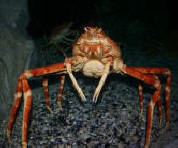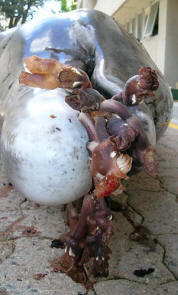|
Class: Crustacea (crabs, lobsters, shrimps, prawns,
barnacles)
Life >
Eukaryotes
>
Opisthokonta >
Metazoa
(animals) > Bilateria > Ecdysozoa > Panarthropoda > Tritocerebra >
Arthopoda
> Mandibulata > Crustaceomorpha
Introduction
The Crustacea are a subphylum within the
Arthropoda that are primarily marine with a few fresh water forms and even fewer
are terrestrial. This large and very diverse group includes marine lobsters,
crabs, shrimps, prawns and barnacles. The name crustacean is derived from their
hard, crusty exoskeleton made from chitin. Although quite diverse, crustaceans
are characterised by having three distinct body parts; the head, thorax and
abdomen. The head region usually bears a pair of compound eyes and five pairs of
appendages (ie., two pairs of sensory antennae and three pairs of mouthparts for
feeding). Biramous (Double branched) appendages on the thorax and abdomen are
arranged segmentally. One branch is usually the gill branch while the other is
the leg branch.
There are over 40,000 species of crustaceans known globally which are classified
further based on complex body, carapace and appendage morphology. The Ostracoda
or seed shrimps have a carapace shaped like that of a bivalve mollusc, which
covers the entire body. The Copepoda or krill are small, often planktonic, lack
a carapace, have 4-6 thoracic limbs and no abdominal appendages. The Cirripedia
or barnacles have a body enclosed by a shell of calcareous plates. The
Malacostraca or shrimp-like or crablike forms have eight pairs of thoracic limbs
and usually possess swimming appendages on the abdomen. At present ~2333
crustacean species are known from South Africa.
   
Ecology
 The
Crustacea occur in almost every habitat of the marine environment,
and are therefore a highly diverse group of organisms. Small
crustaceans like copepods and krill feed on green algae. Barnacles,
which are attached to various substrata live very inactive
lifestyles by filtering the surrounding waters for food. Decopods,
which include lobsters, crabs, hermit crabs and shrimp possess a
thorax that bears walking legs and either scavenge for food or in
some instances capture prey using claws. The
Crustacea occur in almost every habitat of the marine environment,
and are therefore a highly diverse group of organisms. Small
crustaceans like copepods and krill feed on green algae. Barnacles,
which are attached to various substrata live very inactive
lifestyles by filtering the surrounding waters for food. Decopods,
which include lobsters, crabs, hermit crabs and shrimp possess a
thorax that bears walking legs and either scavenge for food or in
some instances capture prey using claws.
Crustaceans are able to form unusual interactions and associations
with other organisms. Zooplanktonic crustaceans like copepods and
euphausids provide a vital link between the phytoplankton they feed
on and larger bodied organisms like pelagic fish, basking sharks,
whale sharks and other whales, all of which in turn feed on them.
Some barnacles occur exclusively on whales like the goose barnacle,
Conchoderma aurita. Hermit crabs are well known for their
behaviour of colonizing empty gastropod shells to protect their soft
skinned abdomens. When they outgrow their shells they seek out new,
larger, ones and on occasion will fight each other for the best
shell. Some crabs may be covered in a coat of long, stiff, brown
hairs, thereby mimicking a sponge. In fact, they sometimes carry a
cloak of sponge, ascidian or seaweed on their backs to ensure that
the crabs are unpalatable and well camouflaged from potential
predators.

The west coast rock lobster, Jasus lalandii, occurs in
shallow water (0-50 m) off the south-western coast from just north
of Walvis Bay (Namibia) to about East London on the east coast of
South Africa. They are fascinating animals, because they make use of
large-scale ocean current systems to transport young away from
parent populations, only for the young to return several months
later to resettle on “home territory”. This large range is
accomplished by the drifting existence of their phyllosoma
(”leaf-organism”) larvae. These larvae moult through at least 11
stages, each time adapting to the prevailing environmental
conditions, before they metamorphose into a swimming stage known as
a puerulus (”little boy”). These transparent miniatures of adult
lobsters are capable of swimming long distances thereby returning to
the area in which the parent stock lives. |
Crustacea and humans
 The
South African rock lobster fishery is based on two species, one a limited
fishery on the south coast taking Palinurus gilchristi, and a second on
the west coast targeting the shallow water species Jasus lalandii. The
latter is caught inshore by traps and hoopnets deployed from small vessels, and
is also harvested by recreational divers, and the former is a deep-water species
caught by means of traps set by larger freezer vessels. The
South African rock lobster fishery is based on two species, one a limited
fishery on the south coast taking Palinurus gilchristi, and a second on
the west coast targeting the shallow water species Jasus lalandii. The
latter is caught inshore by traps and hoopnets deployed from small vessels, and
is also harvested by recreational divers, and the former is a deep-water species
caught by means of traps set by larger freezer vessels.
The commercial fishery for West Coast rock lobster is controlled by
 company-allocated
quotas within a Total Allowable Catch (TAC) subdivided by geographical area. A
reduction in the minimum size that can be legally harvested, from 89 to 75 mm
carapace length, was introduced in April 1992. The TAC was set at 2 200 t for
the 1992/93 season, but, with growth rates staying low, the TAC has since been
reduced progressively. company-allocated
quotas within a Total Allowable Catch (TAC) subdivided by geographical area. A
reduction in the minimum size that can be legally harvested, from 89 to 75 mm
carapace length, was introduced in April 1992. The TAC was set at 2 200 t for
the 1992/93 season, but, with growth rates staying low, the TAC has since been
reduced progressively.
The South Coast rock lobster fishery has been in existence since 1974. No
minimum size limit is enforced and animals are caught from a size of about
 60
mm carapace length upwards. As this means that little protection is afforded to
breeding females, a conservative TAC of 450 t tail mass was set each year from
1984 in order to retain enough surviving adults in the stock to ensure adequate
egg production and recruitment. It was later increased to 475 t, but it is now
declining. For the 2003–2005 seasons (1 October to 30 September each year) the
TAC remained constant at 382 t tail mass. 60
mm carapace length upwards. As this means that little protection is afforded to
breeding females, a conservative TAC of 450 t tail mass was set each year from
1984 in order to retain enough surviving adults in the stock to ensure adequate
egg production and recruitment. It was later increased to 475 t, but it is now
declining. For the 2003–2005 seasons (1 October to 30 September each year) the
TAC remained constant at 382 t tail mass.
The vagaries inherent in the harvesting of wild lobster resources and the
possible negative implications that reduced supply may have on the export
markets stimulated interest in the possible aquaculture of these crustaceans.
However, artificially replicating the environmental conditions necessary for the
phyllasoma larvae to metamorphose has been difficult and so immediate efforts
have been focused on the capture of wild pueruli for on growing in aquaculture
farms.
Classification
Ostracoda
|
|
Copepoda
|
|
Cirripedia
|
|
Malacostraca
|
|
| |
Hoplocarida (mantis shrimps)
|
|
| |
Peracarida
|
|
| |
|
Mysidacea
|
|
| |
|
Cumacea
|
|
| |
|
Amphipoda
|
|
| |
|
Isopoda
|
|
| |
Eucarida
|
|
| |
|
Euphausiacea (krill)
|
|
| |
|
Decapoda (shrimps, crabs, rock lobsters)
|
|
| |
|
|
Natantia
|
|
| |
|
|
Reptantia
|
|
| |
|
|
|
Macrura (rock lobsters and sand prawns)
|
|
| |
|
|
|
Anomura (hermit crabs and porcelain crabs)
|
s.jpg) |
| |
|
|
|
Brachyura (true crabs)
|
 |
|
